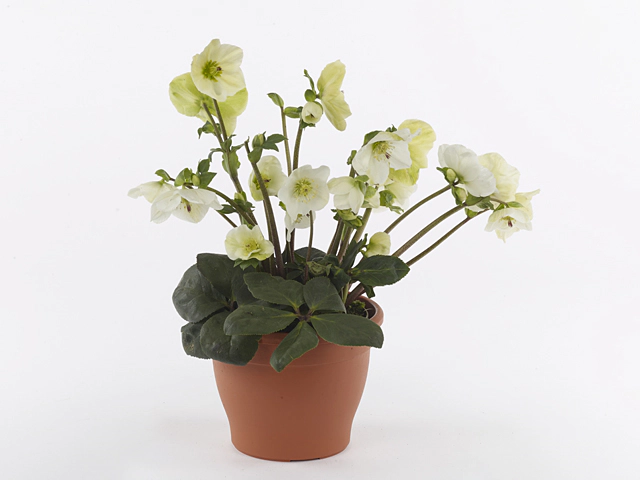Helleborus HGC Linn

| Flower type | Single |
| Flower color | White-white-NN155B |
| Flower diameter | 8,5 - 9 cm |
| Plant height | 20 - 30 cm |
| Flowering month(s) | January; February; March; April; December |
| Leaf size | 15 - 20 cm |
| soil pH requirement | Alkaline (pH > 7,5); Slightly acidic (pH 4,5 - 6,5); Neutral (pH 6,5 - 7,5) |
| Light conditions | Semi-shades |
| Leaf division | Digitate-lobed |
| Leaf, main color | Dark green |
| Flower color distribution | Unicolored |
| Toxicity (if consumed) | Toxic |
| Moisture requirements | Well-drained; Moist |
| Soil type | Humus rich |
Helleborus HGC Linn, also known as Hellebore, is a beautiful flower that belongs to the Ranunculaceae family. This flowering plant is characterized by its single white petals, which are an absolute delight to behold. The flowers have a diameter ranging from 8.5 to 9 centimeters, making them quite sizable and eye-catching.
Growing up to a height of 20 to 30 centimeters, Helleborus HGC Linn stands out as a compact plant that can fit perfectly in any garden or indoor space. It is a perennial plant that blooms during the months of January, February, March, April, and even December, adding a touch of elegance and color to the dull winter months.
The leaves of Helleborus HGC Linn are equally captivating. With a size of 15 to 20 centimeters, they are beautifully divided, forming digitate lobes. The main color of the leaves is a dark, lush green, providing a stunning contrast to the white flowers.
When it comes to soil preferences, Helleborus HGC Linn is not very picky. It can thrive in a variety of pH levels, including alkaline (pH > 7.5), slightly acidic (pH 4.5 - 6.5), and neutral (pH 6.5 - 7.5). This adaptability makes it a versatile plant that can be grown in different areas with varying soil conditions.
In terms of light requirements, Helleborus HGC Linn prefers semi-shaded areas. It thrives when it receives moderate sunlight that is filtered through surrounding trees or other structures. Placing it in direct sunlight for prolonged periods may cause the leaves to wilt and the flowers to fade prematurely.
One important thing to note about Helleborus HGC Linn is its toxicity. The plant is considered toxic if consumed, so it is essential to keep it away from children and pets who may be tempted to explore it. However, when handled with care and kept out of reach, it poses no danger.
For optimal growth, Helleborus HGC Linn requires well-drained soil that retains moisture. It prefers a soil type that is rich in humus, which assists in retaining moisture and provides the necessary nutrients for healthy growth. Proper watering practices and ensuring the soil doesn't dry out too much are key to successfully growing this beautiful plant.
In conclusion, Helleborus HGC Linn, or Hellebore, is a stunning flowering plant that brings beauty and grace to any garden or space. With its single white flowers, dark green leaves, and adaptability to various soil conditions, it is an attractive choice for both beginner and experienced gardeners. Just remember to handle it with care due to its toxic nature and provide it with the right light and moisture conditions for optimal growth.
Market availability index by month:
| Jan. | Feb. | Mar. | Apr. | May | Jun. | Jul. | Aug. | Sep. | Oct. | Nov. | Dec. |
|---|---|---|---|---|---|---|---|---|---|---|---|
| 2 | 1 | 1 | 1 | 1 | 1 | 1 | 1 | 1 | 3 | 4 | 3 |